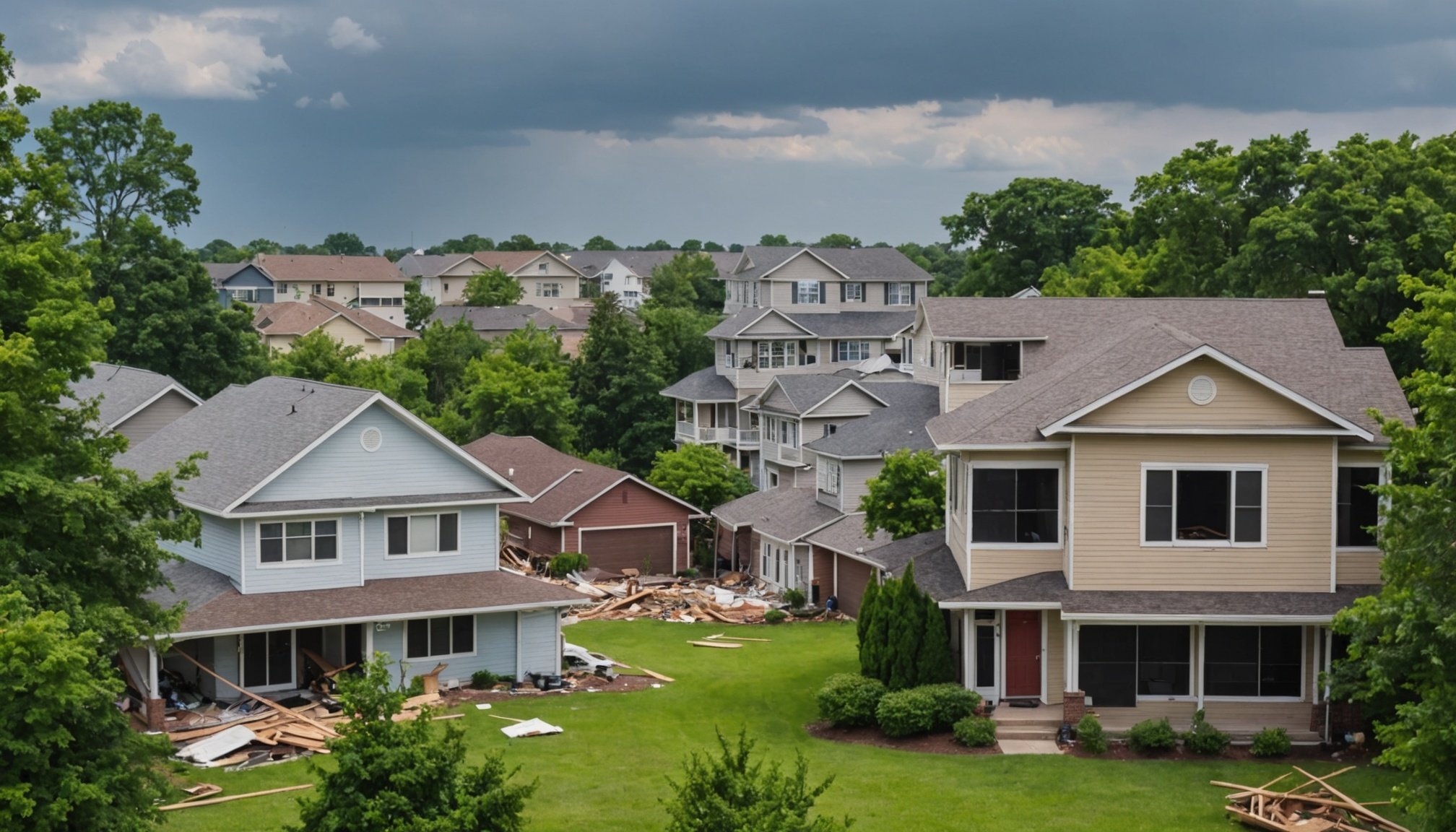Understanding Disaster Risks in Real Estate
Disaster risks are a critical consideration in real estate. The susceptibility of properties to natural disasters such as floods, earthquakes, and hurricanes varies greatly. Each type of disaster has specific characteristics that affect real estate differently. For instance, coastal areas might be prone to flooding and hurricanes, while regions near fault lines face earthquake threats.
Real estate vulnerability is significantly influenced by location. Properties in areas with a history of frequent or severe natural disasters require a more thorough disaster risk assessment. This assessment often involves evaluating the geography, historical data, and predicted climate changes that may elevate disaster risks. For example, a coastal property may require a higher insurance premium due to its flood risks.
This might interest you : Transforming Green Properties: Essential Waste Management Strategies for Successful Sustainable Development
The importance of assessing vulnerability cannot be overstated. Before investing in real estate, understanding its exposure to potential disasters is essential. This involves not just evaluating the property itself but also the surrounding area’s infrastructure and emergency response capabilities. Properly assessing these factors helps investors make informed decisions and potentially mitigates financial loss from unforeseen disaster risks. Being proactive in these evaluations can also lead to better preparedness strategies, ensuring property resilience in the face of natural challenges.
Insurance Options for Disaster Preparedness
Delving into insurance for real estate provides an edge in disaster preparedness. Understanding the nuances of disaster insurance options is crucial for risk management and safeguarding your investment.
In the same genre : Inventive Space-Saving Hacks to Optimize Small Living Spaces
Types of Insurance Policies
Various insurance policies are tailored to address specific disaster risks. Flood insurance covers damages from rising waters, a crucial consideration for properties in flood-prone areas. Earthquake insurance addresses potential structural damages resulting from seismic activities, essential for properties near fault lines. For a more comprehensive approach, enhancements to existing homeowners’ insurance policies might offer additional protection, covering a wider range of potential natural disasters.
Evaluating Your Insurance Needs
Evaluating insurance requirements involves assessing the property value and associated risks meticulously. It’s vital to understand policy exclusions and limitations as not all disasters are automatically covered under standard insurance plans. This means carefully reviewing policies and consulting insurance professionals to ensure that your coverage aligns with your real estate vulnerability.
Claims Process and Documentation
Being prepared for the claims process involves maintaining meticulous records. After a disaster, clear documentation is necessary to navigate the complex claims procedure effectively. Visibility into policy requirements and expectations ensures smoother interactions during the claims process, leading to quicker recovery through insurance support.
Structural Improvements for Disaster Resistance
Strengthening real estate against disaster risks begins with adhering to local building codes. These codes serve as essential guidelines that prescribe construction requirements to withstand specific natural disasters. Following them is crucial for property safety and investment security.
Structural upgrades can significantly enhance real estate vulnerability. Implementing hurricane straps, for instance, strengthens roof connections, reducing damage from high winds. Similarly, reinforced roofs offer additional protection, especially in regions susceptible to hurricanes or heavy snowfall. Such improvements not only fortify buildings against immediate threats but also contribute to their long-term durability.
Investing in disaster-resistant construction offers various benefits. It minimizes potential repair costs, enhancing property value in the eyes of potential buyers or renters. Moreover, it aids compliance with insurance terms, possibly reducing premiums. The initial expense of these upgrades pays off over time, ensuring fewer disruptions and safeguarding livelihoods dependent on the property.
Ultimately, prioritising strong, disaster-resistant construction enhances the overall resilience of a building. When aligned with risk management strategies, these improvements can serve as a powerful tool in protecting real estate investments against unpredictable emergency challenges.
Emergency Planning and Response Strategies
Effectively managing disaster risks requires thorough emergency preparedness and well-developed evacuation plans. These strategies enhance real estate vulnerability mitigation efforts, ensuring safety and property protection during natural disasters.
Developing an Emergency Plan
An effective emergency plan is comprehensive and well-structured. It includes critical components like risk identification, resource allocation, and a communication strategy during disasters. Ensuring that all household or business members are aware of the plan and understand their roles is pivotal. Clarity in information sharing can make a difference during critical moments.
Creating an Evacuation Plan
Crafting a robust evacuation plan is equally essential. This involves pinpointing safe routes and exits and identifying secure locations to regroup post-evacuation. Preparing properties for quick evacuation, such as securing loose objects and shutting off utilities, can significantly minimise natural disasters‘ impact.
Training and Drills
Regular emergency drills are vital for familiarity and quick response. Engaging with community resources for training sessions enhances preparedness through shared knowledge. These practices integrate local insights and ensure readiness on a broader scale, reinforcing network resilience against potential disasters.
Community Resources and Support Systems
When facing disaster risks, utilising available community resources is crucial. These resources often include local emergency services and support networks designed to aid individuals and businesses during natural disasters. Awareness and identification of these services before they are needed ensure a quicker response in emergencies.
Local organisations, such as community centres and non-profits, play a pivotal role in disaster relief and preparedness. These groups often organise training sessions, disseminate crucial information, and offer shelters or supplies during crises. Engaging with these entities can provide significant advantages, such as becoming part of a neighbourhood watch or a community resilience plan.
Leveraging community resources effectively requires proactive involvement. Knowing your area’s emergency plans, attending community meetings, and volunteering for disaster readiness initiatives are practical steps to enhance preparedness. This involvement not only strengthens your personal safety but contributes to overall local support systems.
In the face of unpredictable emergencies, a well-supported community can mitigate the impacts of disaster risks. By integrating real estate strategies with local support systems, property owners can safeguard their investments and promote a resilient response infrastructure.
Checklists for Real Estate Disaster Preparedness
Being ready for disaster involves more than just awareness—having detailed preparedness checklists can ensure comprehensive readiness. These lists cater both to homeowners and investors, offering a focused approach to disaster readiness.
Homeowner’s Checklist
For homeowners, key actionable steps include:
- Stocking essential supplies like first aid kits, water, and non-perishable food.
- Securing important documentation, such as insurance papers and property deeds, in waterproof containers.
- Regularly reviewing and updating emergency contact information.
These measures form the backbone of a solid disaster readiness plan.
Investor’s Checklist
Investors need a broader disaster readiness outlook:
- Evaluate multiple properties for disaster preparedness, prioritising locations less prone to risks.
- Craft long-term investment strategies that integrate potential disaster management plans.
- Diversify portfolios to mitigate property-specific vulnerabilities.
This strategy ensures a holistic safeguard against diverse disaster risks.
Community Engagement Checklist
Engaging with local resources enhances collective disaster readiness:
- Participate in community preparedness meetings to stay informed.
- Encourage information-sharing among property owners to reinforce neighbourhood resilience.
- Be proactive in supporting local disaster drills and training sessions.
These checklist-driven strategies arm individuals and communities, boosting overall disaster management efficacy.
Case Studies on Successful Disaster Preparedness
Exploring case studies of properties that effectively navigated natural disasters provides valuable insights into robust disaster management strategies. Analysing these scenarios reveals critical best practices that can significantly enhance real estate resilience.
In one instance, a coastal property successfully weathered a severe hurricane due to targeted disaster-resistant construction upgrades. Implementing features such as reinforced roofs and hurricane straps protected the property from high winds and minimized damage. The decision to prioritise building code adherence and invest in structural improvements paid off, showcasing how preparation can safeguard property and reduce repair costs.
Another enlightening example highlights how risk management is critical. A business in an earthquake-prone area integrated precise earthquake insurance and established comprehensive emergency plans. Regular training sessions ensured readiness, while strategic policy enhancements facilitated a smooth claims process post-disaster, enabling rapid recovery.
These case studies illustrate that combining structural, insurance, and preparedness strategies is crucial in facing potential disaster risks. Learning from these experiences underscores the importance of proactive measures, illustrating innovative methods employed by property managers to fortify and protect their assets. By adopting these best practices, real estate investments can be better shielded against the unpredictable impacts of natural events.











